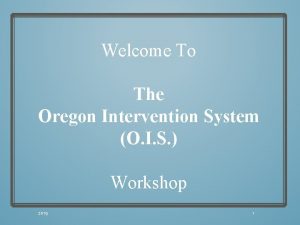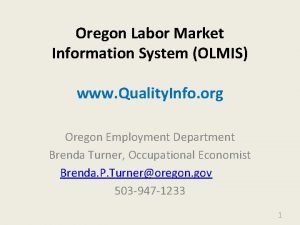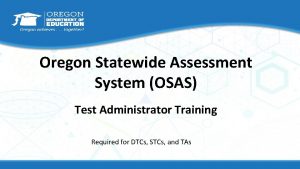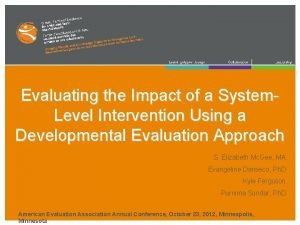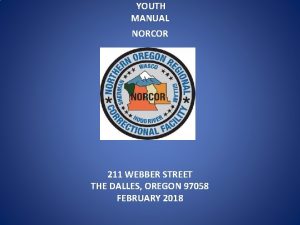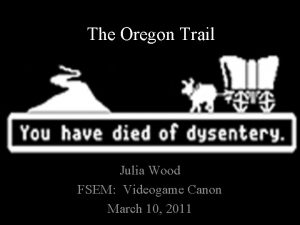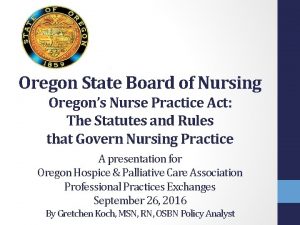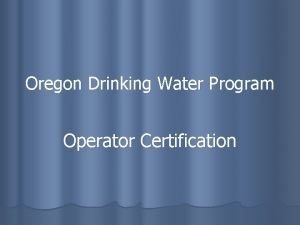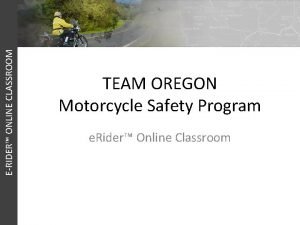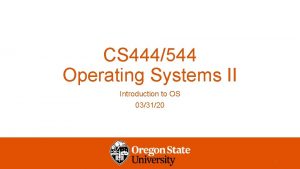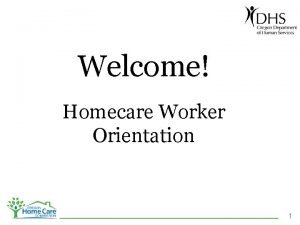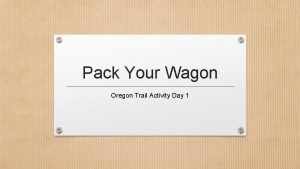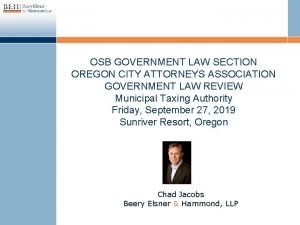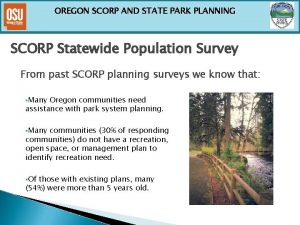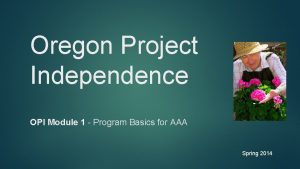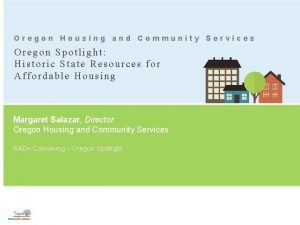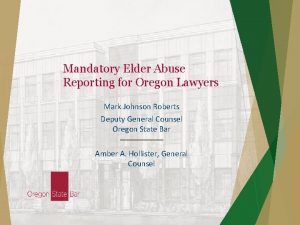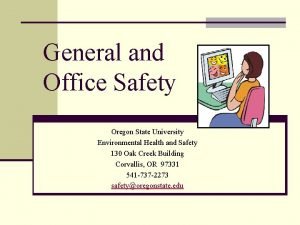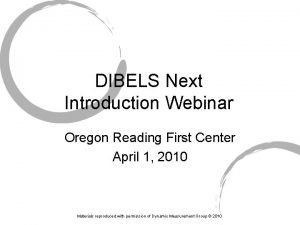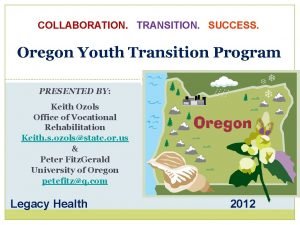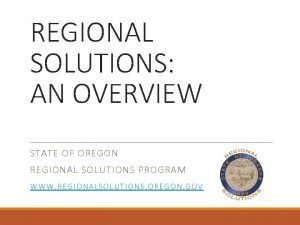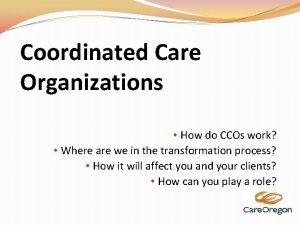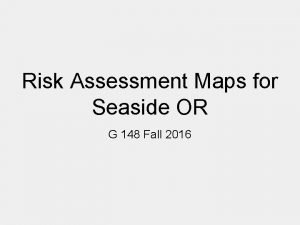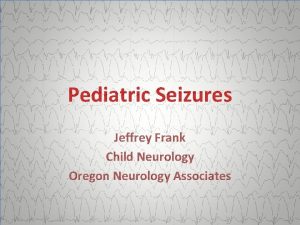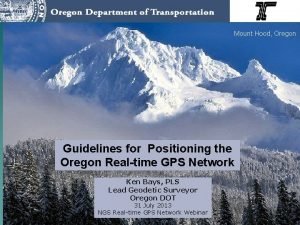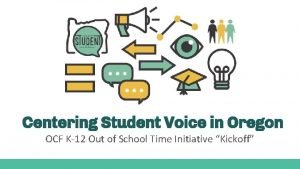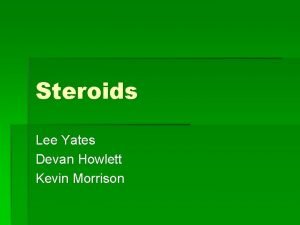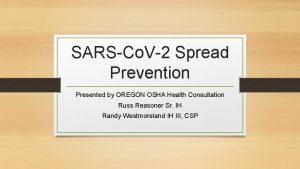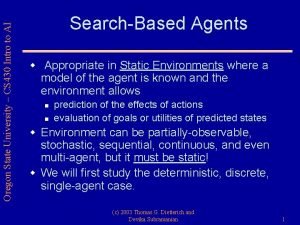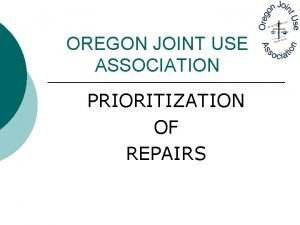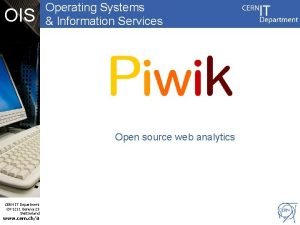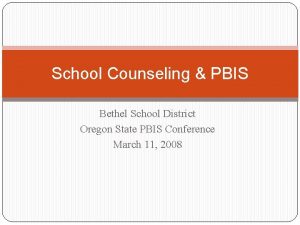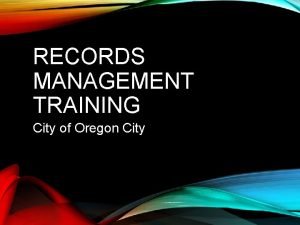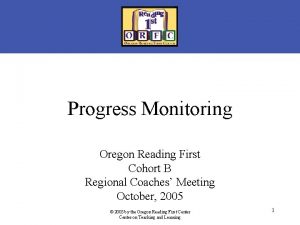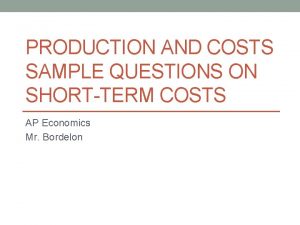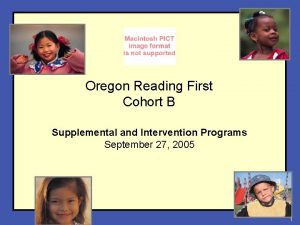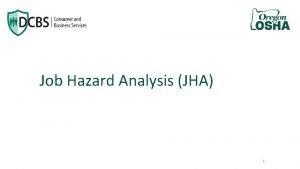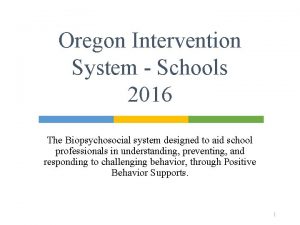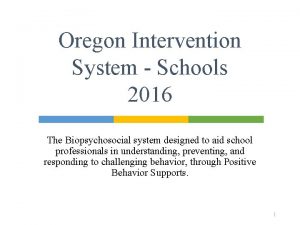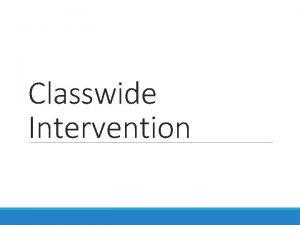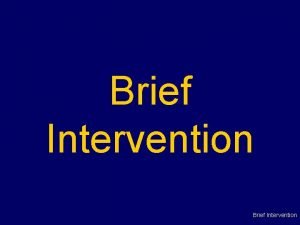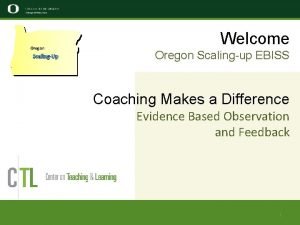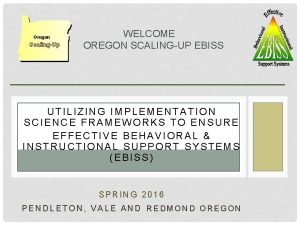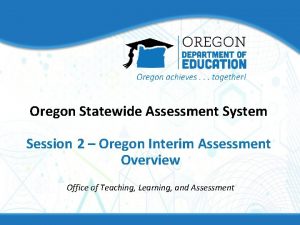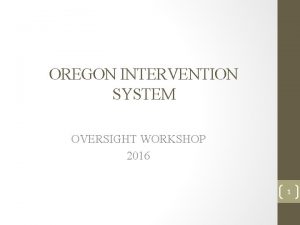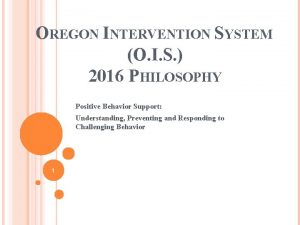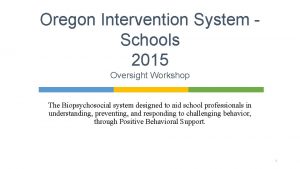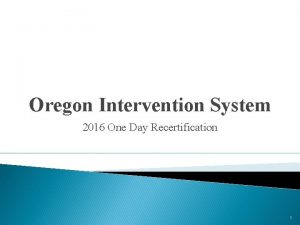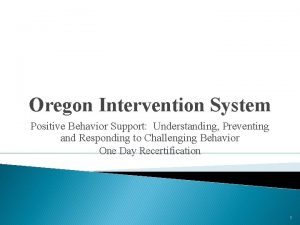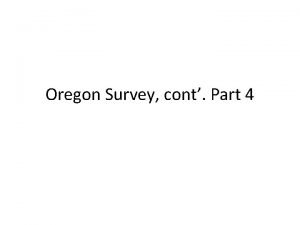Welcome To The Oregon Intervention System O I


























































































































































- Slides: 154

Welcome To The Oregon Intervention System (O. I. S. ) Workshop 2019 1

Brief Introductions 2019 2

Workshop Behave in a professional manner! Demonstrate respect for others Be considerate Be on time for workshop and from breaks Turn cell phones and other electronics off/silent Respect confidentiality! Participate in group discussions 3 3

This Workshop will include: O. I. S. Overview, Values, and Positive Behavior Support Module 1: Relationships and Communication Module 2: Understanding Behavior Through Trauma Module 3: Positive Behavioral Supports - Presets Module 4: Positive Behavioral Supports – Setting Events and Challenging Behavior 101 Module 5: Positive Behavioral Supports – Quality of Life Module 6: Mental Health Introduction Mental Health Disorders or Autism Spectrum Disorder Module 7: Stress and Emotional Control Module 8: Emergency Crisis Management 4

O. I. S. Overview O. I. S. is an evidenced based system to assist Designated Persons in understanding, preventing, and responding to challenging behavior, through Positive Behavior Support. 5

O. I. S. Values � Respecting rights, treating others with dignity, and acknowledging their citizenship. � Person Centered: Behavioral challenges are approached on an individual basis. Although similarities may occur, each behavioral challenge is unique to the person. � Behavioral challenges are complex and require a teambased collaborative decision-making process. 6

O. I. S. Values � Challenging behaviors are approached from the evidenced based framework of Positive Behavior Support. � The core principles of O. I. S. emphasize the importance of proactive and preventative strategies rather than “reactive” strategies. 7

O. I. S. Values Professional Integrity 8

Class Exercise Develop a list of at least 5 staff strategies in each of the following categories: Valued Practices Questionable Practices Unethical Practices 9

POSITIVE BEHAVIORAL SUPPORTS (PBS) � As noted in the OIS Values, PBS recognizes challenging behaviors are complex and the supports are person centered. � A major goal of PBS is helping the individual to learn to enjoy their lives and living as independently as possible. � PBS recognizes that those individuals receiving these supports have rights as any other citizen. � PBS also recognizes that these supports are developed in ways that maintain the individuals dignity. 10

POSITIVE BEHAVIORAL SUPPORTS (PBS) � The challenge for designated persons performing PBS is not focusing on the problem, rather focusing on the outcome of the support. � Relationships, Communication, Trauma, past Behavioral approaches, and Quality of Life are all components in assessing and understanding challenging behavior from a PBS viewpoint. � OIS incorporates these assessments within this workshop. 11

Module 1: RELATIONSHIPS and COMMUNICATION 12

Relationships A sense of belonging is a basic human need (Pellentier, 1994). • People with satisfying relationships are: • • • Happier Have fewer health problems Live longer (Harvard Medical School, 2010) 13

Sad Truth • Many individuals we support have no friendships in the community. • Family relationships may be tentative, infrequent, or non-existent. • Although paid providers can be wonderful, these relationships are often conditional and fleeting. 14

What’s important • The relationship with paid providers is often rated by individuals with intellectual disabilities as highly important (Willems, 2016) • Parents of people with intellectual disabilities and people with intellectual disabilities want Designated Persons that are: • • Positive and friendly Listen sincerely, with sensitivity Show real interest Handle power/authority in an acceptable manner • Respectful, empathetic, and accepting • Able to build a trusting relationship Clarkson, Murphy, Coldwell, & Dawson, 2009; Dodevska & Vassos, 2013; Moonen, 2006; Roeleveld, Embregts, Hendriks, & Van den Bogaard, 2011; Van der Meer, Embregts, Hendriks, & Sohier, 2011 15

Building Relationships • Begin your relationship by getting to know the person, not jumping into the personal care part of your job immediately. • Relate to the individual through interests. • Be interested in the individuals interests even if you don’t share the same passion. 16

COMMUNICATION in RELATIONSHIPS https: //www. ted. com/talks/celeste_headlee_10 _ways_to_have_a_better_conversation? languag e=en&utm_campaign=tedspread&utm_medium =referral&utm_source=tedcomshare 17

18

Communication in Relationships Exercise Write a one sentence definition of : Effective Communication: The means through which people exchange information, feelings, and ideas with each other. Often times this is difficult for those we support. 19

Communicating with Empathy https: //www. youtube. com/watch? v=1 Evwgu 369 Jw 20

Communication in Relationships By not feeling the same emotion of the other person… By truly not listening to the person’s communication… Our communication could go wrong 21

When Communication Goes Wrong http: //www. youtube. com/watch? v=Kti. JAexx. SPo 22

What is a Power Struggle? A person wants to do something (or avoids doing something) and we don’t honor their decision. The person becomes upset because his/her decision is not being honored. As the person escalates, we “dig-in” on our position. Power Struggle 23

Avoiding Power Struggles • Do • Be Compassionate • Make it a teaching moment • Allow individuals to save face • Use I-statements • Focus on the individual’s feelings instead of the behavior • Don’t • React unless the behavior becomes dangerous • Let your emotions control your behavior • Attempt to get the last word • Use language that puts the person on the defense 24

Resolving Power Struggles • Power struggles tend to escalate as they cause both parties to become stressed. • It is not always easy to stop the escalation. • Recognizing that you are in a power struggle is the first step. 25

Resolving Power Struggles • Disengaging techniques – Use a brief, simple, stress-reducing technique prior to responding (e. g. deep breath) – Use a calm, neutral, matter of fact voice tone – Avoid reacting to every response – Keep the response brief 26

Resolving Power Struggles • Interrupting techniques (well timed, supportive responses that interrupt the escalation) – Divert attention from the conflict – Engage the person in a neutral task – Ask who, what, where, when and how questions (avoid why questions) – Offer a break – Paraphrase concerns 27

Resolving Power Struggles • De-escalating techniques – Turn a negative statement into a positive statement. – Use body language to defuse the situation – Help the person save face – Use humor – Label the emotion – Consider what the person is trying to convey with their behavior. 28

How we communicate is influenced by our beliefs and biases 29

EXERCISE 30

Our Beliefs Matter • Beliefs are the guiding principles in life that assist us in making decisions and give life meaning. • Beliefs originate from our experiences and environment. • Beliefs filter our perceptions of the world (external and internal). 31

Biases Bias is when we make decisions based upon a category attribute, our assumptions, and our beliefs. Game: 32

Supported by Research Smart rats vs. Dumb rats Gifted students vs. average students 33

Beliefs and Bias Cycle Personal Beliefs and Biases Which affect our behavior toward the people we support Influence our decisions 34

Summary • Building and maintaining positive relationships with the people we support is the foundation of our field. • How we listen in our communication is an important part of relationships. • Our communication is influenced by our biases and beliefs. 35

MODULE 2 Understanding Behavior Through Trauma 36

37 Trauma is any experience or series of experiences that make the individual feel that he or she is in danger of dying, or of being emotionally “wiped out” or annihilated. (Palay, 2013) Trauma destroys the instinct of purpose (Van Der Kolk, 2018) Traumatized people are all feelings (Van Der Kolk, 2018)

38 Sobering Statistics U. S. Department of Justice 2011 Report • Only 37. 3% of individuals with disabilities who were the victims of abuse reported their abuse to the authorities. • In 52. 5% of the cases that were reported, nothing occurred as a result of the reporting. • For individuals diagnosed with autism, 77% reported having been bullied; for individuals diagnosed with intellectual developmental disabilities 64. 3% reported having been bullied. Age-Adjusted Rates of Violent Victimization per , 1000 People with Disabilities People Without Rape/Sexual Assault 2. 7 0. 9 Robbery 8. 3 1. 8 Aggravated Assault 10. 6 3. 3 Simple Assault 26. 1 13. 4 Males 42 22 Females 53 17 S. Mc. Gilvery, Ph. D. , 2018

39 Types of Trauma for Individuals with I/DD • The disability itself • Emotional, Sexual, and Physical Abuse • Institutionalized living • Bullying, teasing, social rejection • Loss of relationships including family, staff, and peers • Changes in living environments • Loss of job

40 Big “T” Trauma Life events that cause severe disruption to the normal patterns of ones life may be considered big T trauma: v. Sexual/Physical Assault v. War v. Natural or manmade disasters v. Catastrophic illness v. Traumatic loss of a love one v. Prolonged deprivation and powerlessness to act on one’s own behalf

41 Little “t” Trauma • When one’s coping is limited and common stress-inducing experiences are repeated or become chronic, the frequency of those experiences may lead to little “t” trauma. ØFeeling different ØNot being accepted/social isolation ØFeeling humiliated ØNot being able to do what others do ØMoving to a new home or significant change at home ØNot being listened to ØBeing misunderstood ØFailing at a task ØGetting confused or overwhelmed (Ford, Adler-Tapia, 2009)

42 The Brain and Trauma • The brain does not differentiate between physical, emotional, or observatory trauma. All are interpreted by the brain as trauma. (Palay, 2013) • After an individual experiences a traumatic event their world is experienced with a different nervous system as their perception of risk and safety have been altered. (Van Der Kolk, 2014)

43 TRAUMA https: //vimeo. com/100518405

44 Manages Incoming/Outgoing Messages Links Nervous & Endocrine Systems Smoke Detector Learning and Memory

45 The Amygdala • As we noted in the diagram, it is located under the hippocampus and on both sides of the brain. • Identifies threats • Exists in the present; relies on other parts of the brain to place threats in context • Sets into motion (1/20 of a second) flight-or fight chemical norepinephrine, cortisol • Decides between need for aggression or fear

46

47 The Emotional Brain https: //www. youtube. com/watch? v=2 m 7 kt. Hq 1 Nn 0

48 Trauma and Behavior • We recognize that Trauma affects an individuals ability to manage their emotions and affects their behavior and mental health. • Therefore, our Behavioral Interventions should acknowledge that the behaviors exhibited are symptomatic of Trauma and dysregulated emotions.

49 Trauma Behavioral Pyramid Trauma Behavior Emotion Dysregulation al ic Phys Trauma Observatory Em otio n al (Harvey, 2013)

50 Remember • When the “Emotional Brain” is activated the “Rational Brain” is “off line” • Using words to calm someone who is “reactive’ is not attending to the Emotional Brain but to the Rational Brain.

51 Four S’s Seen. Safe. Soothe. Security- (Siegel, 2013) being understood, realized, perceived, appreciated, within one’s mind being protected, sheltered, unharmed, secure calming, quietening, relaxing reassurance, well-being, refuge, safekeeping

52 Summary • The people we support experience trauma more frequently than those without intellectual disabilities. • Trauma affects how the brain functions and how the individual behaves. • Trauma affects the individuals ability to manage their emotions.

POSITIVE BEHAVIORAL SUPPORTS Module 3 - PRESETS Possible Precursors to Challenging Behavior 2019 53

POSITIVE BEHAVIORAL SUPPORTS Presets are the biological, psychological, and sociological conditions that affect the person. These presets are the internal events for the person that, at times, may not be well managed. What three presets have we already discussed today? 2019 54

POSITIVE BEHAVIORAL SUPPORTS Biological Presets - Physical Health Aspiration, Dehydration, Constipation, Seizure Weight Management Diabetes Tooth pain Heart conditions Medication side-effects (headaches, nausea, dizziness, agitation, etc. ) Allergies Skeletal maladies Artificial skeletal supports/replacements Muscle or joint pain Menses Urinary Tract Infections (UTI) 2019 55

POSITIVE BEHAVIORAL SUPPORTS Biological- Mental Health Concerns Post Traumatic Stress Disorder Depression Anxiety Bipolar Disorder OCD ADHD Sleep Disorders Pica Dementia 2019 56

POSITIVE BEHAVIORAL SUPPORTS Psychological Presets Learning Negative thinking Emotional Regulation Rejection by others Loneliness Uncertainty Fearful 2019 57

POSITIVE BEHAVIORAL SUPPORTS Executive Functioning https: //www. youtube. com/watch? v=FZLXggs. K 6 o. A 2019 58

POSITIVE BEHAVIORAL SUPPORTS Psychological Presets: Learning and Thinking: Thinking and Learning involves our Executive Functions located in the Frontal Lobe. These functions include: Attention Working Memory Planning, Organizing Forethought Impulse Control 2019 59

60

POSITIVE BEHAVIORAL SUPPORTS Psychological Presets: Emotional Regulation Our emotions arise when we perceive and place value on internal and external stimulus. Emotional Regulation occurs based upon the valuation of the emotion itself. 2019 61

POSITIVE BEHAVIORAL SUPPORTS Emotional Regulation https: //www. youtube. com/watch? v=9 n 5 Mq. KLit. Wo 2019 62

POSITIVE BEHAVIORAL SUPPORTS Emotional Regulation Five Families of Emotion Regulation Processes Situation Selection: “Taking actions that make it more/less likely that we will end up in a situation we expect will give rise to a desirable/undesirable emotion”. (p. 11) Situation Modification: “Directly modify the situation so as to alter its emotional impact”. (p. 12) Attentional Deployment: Through concentration and distraction “directing (your) attention within a given situation in order to influence emotions: . (p. 12) Cognitive Change: “Changing how we appraise the situation we are in to alter its emotional significance”. (p. 14) Response Modulation: “Influencing the physiological, experiential, or behavioral responses” to the emotion. (p. 15) 2019 63

Emotional Dysregulation Extremely angry or anxious!! Angry Frustrated, nervous, anxious Bothered, irritated Doing great, content • Individuals who struggle with Emotional Regulation tend to react in the emotional extremes (1 or 5). • They have difficulty staying and managing in the middle (24). • Therefore, they tend to over or under react to situations (Brown, 2018). 64

We Can Become Dysregulated Too! “If she wanted to stop she would. ” “He acts like that on purpose. ” When Designated Persons have these thoughts/beliefs, it will show in their interactions and contribute to the individual’s dysregulation, which also affects relationships 2019 65

POSITIVE BEHAVIORAL SUPPORTS Sociological Presets � Relationships � � Living Environment Family Friends Community � � � � Inclusion Clubs Sports Volunteer organizations Favorite activities 2019 66

POSITIVE BEHAVIORAL SUPPORTS Module 4 – Setting Events and Challenging Behavior 101

Setting Events What “sets” up the behavior: Ø Internal Events Ø Stomach ache from constipation Ø Traumatic memory Ø Feeling anxious Ø Medication side effects Ø Loneliness Ø Tired Ø Pain Ø Hunger Ø Perceived lack of control Ø External Events Ø Transitions Ø Environments Ø Lack of preferred activities Ø Competition for Designated Persons attention Ø Not able to access the community when desired Ø Diet restrictions Ø Actual lack of control 68

Levels of Supervision Routine Close Constant 69

ADDICTIVE NEEDS LEGAL / ILLEGAL 70

Environment Ø The environment has a substantial impact on behavior. Ø Modifying the environment may have an immediate effect on behavior. 71

Appearance and Dress ØHow do we dress? ØSafe, modest & comfortable ØLeave items home if they interfere ØWhat does grooming say about us? ØAwareness of our scents & smells ØIndividual considerations 72

Routines and Rhythms § Having routines and rhythms of our day, week, month, and year is important. § They can decrease anxiety and stress. § Everyone relies on routines to a certain degree. Routine activities and rhythm enable us to function effectively and comfortably. Now let’s examine your routine 73

POSITIVE BEHAVIORAL SUPPORTS What is Behavior? What is a Challenging Behavior? “A behavior can be describe as challenging when it is of such an intensity, severity, frequency, and duration as to threaten the Quality of Life and/or the physical safety of the individual or others; AND is likely to lead to responses that are restrictive, aversive or result in exclusion” (Emerson, 2011) 2019 74

POSITIVE BEHAVIORAL SUPPORTS Challenging Behavior Ø Is possibly nothing more than the individual experiencing or having a really “bad” day. Ø An individuals inability to process incoming information because of deficits in executive functioning (preset). Ø An individuals inability to regulate their emotions as they are feeling overwhelmed (setting event). 2019 75

POSITIVE BEHAVIORAL SUPPORTS Behavior has Consequences There are two forms of Consequences: 1. Reinforcers: increase the likelihood of behavior happening again 2. Punishers: decrease the likelihood of behavior happening again (in theory) 2019 76

POSITIVE BEHAVIORAL SUPPORTS Reinforcement Ø Reinforcement must meet the same function as the problem OR is larger and more reinforcing than the function of challenging behavior. Ø Purpose Ø Encourages desired behaviors ØStarts new behaviors ØMaintains mastered behaviors 2019 77

POSITIVE BEHAVIORAL SUPPORTS Ø Reinforcement is the best practice and most effective way to alter behavior. Ø Reinforcement should never be provided following an undesirable behavior or any behavior we want to decrease. Discussion 2019 78

POSITIVE BEHAVIORAL SUPPORTS Punishment Ø The application of punishment (in theory) reduces the chances of a particular behavior’s re-occurrence. Ø By this definition, punishment will reduce problem behavior. But at a cost. . . 2019 79

POSITIVE BEHAVIORAL SUPPORTS Punishment Ø Effective in the presence of the punisher. Increase covertness. Ø Requires greater resources to be effective. Increasing severity, constant vigilance Ø Produces unintended consequences: Damages relationships, anger & aggression, changes worldview. 80

N ME SH NI PU T 81

Summary Ø Before every challenging behavior there are presets and setting events. Ø Focusing on the presets and setting events can minimize the challenging behavior. Ø Consequences occur after behaviors and can be reinforcing or punishing. Ø We do not use punishment. 82

Positive Behavioral Supports Module 5 • A high quality of life may be a protective factor for trauma (SAMHSA, 2015). 83

Quality of Life • The quality of life includes satisfaction in these areas: • • • Social relationships Personal satisfaction (self-confidence, happiness) Self-determination (choice, control, independence) Recreation and leisure opportunities Community inclusion (Carr, Dunlap, Horner, et. al, 2002) 84

Quality of Life Model Interpersonal Relationships Material Well Being Physical Well Being 85

Enhance Community Friendships to Increase Quality of Life • Expanding connections within the community allows for opportunities to make friendships. • Teach and practice social skills. Encourage individuals to be respectful with fellow community members. • Model respectful behavior. • Engage the individual in community activities that includes their interests. 86

Quality of Life Systems Level Qo. L Principle Strategy Individual Empowerment Decision Making, Choice Making Skill Development Risk Taking, Goal Setting, Functional Training, Enhance i. ADL skills Involvement Integrated Employment Community Inclusion Inclusive Education Safe & Secure Predictability Personal Control Supports Alignment Supports aligned to personal goals Accessibility Ensuring human rights Attitudes Community Education Teach Social Skills Organization Society 87

Exercise Break into pairs and discuss how you encourage: • Social relationships • Personal satisfaction (self-confidence, happiness) • Self-determination (choice, control, independence) • Recreation and leisure opportunities • Community inclusion 88

Affects on Mental Health • Many individuals with I/DD have many more experiences outside of their “external locus of control” such as: Making decisions/choices, what relationships may be developed, or what activities they may participate inv through guardianship, v through systemic structure, or v through defined levels of supervision. • The lack of relationships and quality of life is one factor that could affect one’s mental health. 89

Module 6 Mental Health Introduction Mental Health Disorders With Intellectual/Developmental Disabilities 90

Mental Health Disorders with Intellectual Developmental Disabilities (I/DD) • Prevalence in United States Total US Population (U. S. Census Bureau, 2010) 368, 745, 538 Number of People in Total Population with I/DD 5, 156, 050 Number of People with I/DD Who Have Mental Illness 1, 701, 496 (33% of I/DD) Hobden & Le. Roy, 2009) 91

Mental Health Disorders • The co-existence of Intellectual/Developmental Disabilities (I/DD) and Mental Illness is well established in research literature. • Individuals with I/DD can experience the same mental health disorders as the general population. 92

Mental Health Disorders/IDD • Although there have been numerous research studies with mental health disorders and I/DD, few have employed the rigorous scientific methodologies required to support the presence of co-occurring disorders. • However, those studies which have utilized the rigorous scientific methodologies have indicated that psychiatric disorders in people with I/DD are at a higher rate than in the general population. (DM-ID-2) 93

Mental Health Disorders/IDD A study in 2007 by researchers in Europe involved 1, 023 adults with I/DD • Findings of study: • 40. 9% of the individuals were determined to have mental illhealth • 37% had mental ill-health excluding autistic spectrum disorder • 28% had mental ill-health excluding problem behaviors • 22. 4% had mental ill-health excluding problem behaviors and autistic spectrum disorders 94

Mental Health Disorders/IDD • Within the USA, a 2016 study provided by the National Core Indicators, indicated that 55% of people with I/DD had a co-occurring psychiatric disorder. • The study was based on input from 30 states utilizing 13, 466 patient charts • The importance of studies of this nature assists in demonstrating the prevalence rates for individuals with mental health disorders and I/DD. 95

Mental Health Disorders/IDD • One possible factor that individuals with I/DD may develop a mental health disorder is stress. • Individuals with I/DD are more vulnerable to stress than people who do not have I/DD. • Vulnerability to stress may be a product of limited life experiences, limited opportunities and options in life, expectations that can exceed their abilities, and past learning experiences. 96

Mental Health Disorders/IDD • Individuals with I/DD may have life experiences that have left them feeling helpless allowing them to become overly dependent on caregivers for support. • This dependency can affect their mental health as the support given may be removed through attrition of support staff or removal from their home. • These factors may then cause problems within interpersonal relationships, which can affect the individuals employment, school, or home environment. 97

Mental Health Disorders/IDD Cultural Concerns • What types of cultural features should be considered? ? • Culture can be ethnic, religious, socio-economic, genderbased, disorder-based • What is their familial history? • Has the culture been supportive towards the individual with mental illness or negative with low expectations from significant others? 98

Signs a person with I/DD may have a Mental Illness (NADD 2015) • Increased anxiety, panic, or fright • Hearing, seeing feeling imaginary things (hearing voices is not the same as talking to oneself or company, to process thoughts, or self-talk to reduce anxiety • Need for instant fulfillment/gratification • Unusual sleep patterns (Insomnia or lengthy periods of sleep) • False beliefs (delusional thinking or paranoia) • Excessive reactivity/moodiness • Memory problems (worsening memory or change in memory) • Accelerated speech patterns • Changes in appetite (loss of weight or increase in weight) • Heightened emotional sensitivity 99

Signs a person with I/DD may have a Mental Illness (NADD 2015) • Decline in personal hygiene • Inappropriate expressive reactions • Family history of mental illness • A functional or behavioral change • Self-isolation • Lingering sadness • Self-injurious behavior • Suicidal ideation 100

Signs a person with I/DD may have a Mental Illness Possible Indicators • The behavior occurs in all environments; it is not just exhibited in specific settings. • Behavioral strategies have been largely ineffective. • The individual doesn’t appear to have control over their behavior. They don’t appear to be able to start or stop the behavior at will. 101

Mental Health Disorders/IDD Support Staff Approaches • Always validate a persons reality, don’t try and talk a person out of their beliefs. • Listen for feeling, not content • Demonstrate understanding and offer choices • Ensure their safety or a plan for safety 102

Mental Health Disorders/IDD Biological Culture Psychological Individual Family Sociological 103

Mental Health Disorders Autism Spectrum Disorder 104

105 MODULE 7 Stress and Emotional Control

Stress https: //www. youtube. com/watch? v=9 LZ 35 Ar 3 r 2 k 106

Not “Good” or “Bad” Productive Stress Examples Feels Unproductive Stress • Upcoming competition • Deadlines • Buying a home • Doing something your not skilled at • Car breaks down • Relationship problems • Focused • Energized • Challenged • • Tense/anxious Overwhelmed Angry Withdrawn 107

Chronic Stress • Chronic stress can occur in response to everyday stressors that are ignored or poorly managed. 108

Problems Associated with Chronic Stress • • Headache Diarrhea Heartburn High Blood Pressure • Increased Risk of Diabetes • Mood Swings • Anxiety • • Anger Irritability Trouble sleeping Difficulty concentrating • Isolation • Loneliness • Lack of interest in activities 109

Stress Management • This profession is stressful! It is important to proactively and reactively manage your stress. • Our support of the person is limited by our stress level. • Stress can be managed with activities that require physical and mental energy. • • • Physical exercise Gardening Journaling Meditating Deep Breathing 110

Not managing our ongoing stress can lead to: Abuse and Neglect 111

Abuse Definition • • • Financial Exploitation Physical Abuse Sexual Abuse Verbal Abuse Involuntary Seclusion Wrongful “Restraint” Remember: Only 37. 3% of individuals with disabilities who were the victims of abuse reported their abuse to the authorities. 112

Abuse/Neglect • “I always define abuse as an action and neglect as not doing an action” (OIS Workshop Participant, 2018) 113

Neglect Definition • Failing to provide care or supervision to maintain physical and mental health that may result in physical harm or significant emotional harm. • Willfully withdrawing or neglecting duties and obligations as a Designated Person. 114

Ecological Framework of Abuse/Neglect Potential offender characteristics Potential victim characteristics Cultural context Potential Abuse/Neglect Situation Immediate physical environment 115

Abuse/Neglect Prevention • Have an Emotional Regulation Strategy • Hold your fellow teammates accountable • Create a work culture that values the person you support. • Manage your stress both at home and at work. • Use your Thinking Brain in crisis situations. 116

Acute Stress A feeling when we react to particular events that have a high probability to affect our lives. It’s the body’s way of rising to the challenge and preparing to meet a tough situation with focus, strength, stamina and heightened alertness. 117

Stress Response • Our brains assess a threat in terms of whether or not we can handle it. • You don’t have to be directly involved in the event to experience stress. • We can’t always differentiate between real and perceived threats. 118

Influential Factors • • Confidence Previous Outcomes Training Beliefs Values Goals Culture Social Norms 119

Managing an Emergency Crisis Situation • When a person is engaging in a crisis behavior, the goal is often. . . MAKE IT STOP NOW! • Instinctually, humans may want to use violence to solve problems. • Learning non-violent ways to solve problems takes emotional self-control and resources within our brain (including executive functioning). 120

Two Brains in One • Our brains have several functions. Two are: – Thinking brain – Survival brain • Each of these brains have specialized functions that work together, but sometimes those specialized functions are at odds with each other. I must use an O. I. S. deflection Thinking Brain Quick, protect my pretty face, I don’t care how! Survival Brain What your brains are thinking when a fist is coming towards your face www. rightresponse. org 121

Alarm Reaction • An alarm reaction occurs when your safety is threatened. • This causes your survival brain to take charge, shutting down your thinking brain. Alarm reactions are NOT useful when responding to a challenging issue! 122

Alarm Reaction Process • The alarm reaction causes fight or flight. • When fight or flight is not possible we freeze. • Freezing is temporary. All of these responses shut down the thinking brain. 123

Physiology of Alarm Reaction How we know its happening 124

Stress Cycle Key Unspoken Stress Staff emotions Staff actions Beyond De-escalation 10% Crisis Escalation 50% ↓ Antecedent De-Escalation 75% Stabilization Baseline 80% ↑ Post-Crisis Drain 125

Summary • We must develop and utilize our stress management plan to maintain good mental health. • When faced with an emergency crisis situation we need to use our thinking brain and not our survival brain. • By not managing our stress we could be more vulnerable to possible abuse and neglectful situations. 126

MODULE 8 EMERGENCY CRISIS MANAGEMENT 127

“When feeling threatened you may become reactive, and when you are reactive you cannot engage in a supportive connecting communication with another person” (Siegel, 2013) 128

EMOTIONAL REGULATION STRATEGY • Everyone needs a strategy to assist with emotional regulation. • This is especially true in emergency crisis situations where your fight or flight response has been activated. 129

DEVELOPING AN EMOTIONAL REGULATION STRATEGY • Mandatory Individual Exercise: • Identify what you may do if the alarm reaction is activated. • Identify potential triggers • Identify physical warning signs • Pay attention to your thinking • List techniques that may help you stay in control during a crisis situation. 130

Emotional regulation strategy must be developed, practiced, and revised throughout your career and personal development. It is the mechanism that we use to minimize the likelihood that we will have an Alarm Reaction. 131

OUR OWN STRESS RESPONSE • Brains respond to other brains. Only when you are centered and calm are you able to help the person who is in CRISIS become centered and calm. • REMEMBER, WHEN A PERSON IS IN CRISIS, THEY ARE EXPERIENCING AMYGDALA HI-JACKING. • When this occurs, you are approaching someone who is functioning with their Right Hemisphere and the Left Hemisphere is deactivated. 132

133

ASSESSING THE SITUATION • Teaching and negotiating during escalation is non-productive • However, a person’s response to your negotiation is a good indication of their escalation. • Their response is feedback for you on how you should respond. 134

POWERS OF OBSERVATIONUSE ALL OF YOUR SENSES: • Changes in frequency, duration, and intensity of behavior • Changes in facial color, expressions, or moods 135

PERSONAL SPACE • Personal space is an approximate area surrounding an individual in which other people should not physically violate in order for them to feel comfortable and secure. • It is the zone around individuals which they regard as psychologically theirs. Class Exercise 136

137

138

CHOOSING OUR RESPONSE When responding to someone who is experiencing escalation in emotional dysregulation, we need to match our response to the intensity and severity of the situation. 139

WHAT TO CONSIDER • Likelihood of injury • Intensity of the situation • Severity of injury • Possible outcomes of the situation • Established Protocols 140

CONCEPT OF REASONABLE RESPONSE Just enough intervention (physical or nonphysical) for protection from injury and no more than is absolutely necessary. Less risk of injury by the intervention than what is threatened by the behavior. 141

What we see. . . Reasonable Response Escalation • Threats • Intimidation • Yelling 1. Maintain Emotional Control 2. Follow BSP or other Guidelines/Protocols 3. Utilize a support as previously outlined. Minor Physical Contact 1. 1, 2, and 3 above. • Likely won’t result in needing medical 2. O. I. S. Evasions and Deflections attention • For example: Pinch, scratch, slap, grab, hit Major Physical Contact • Likely to result in an injury requiring medical attention 1. All of the above 2. Possibly a PPI or 911 142

RESPONDING TO ESCALATION • Remember: • The “thinking brain” of all escalated people is turned off • Managing the escalating person means we have to appeal to their survival/emotional brain • At this point in the crisis the goal is to keep everyone safe! 143

REASSESS THE SITUATION • Ask yourself, “What is going on? ” • Use grounding/directive statements to the person • State their name • “Stop” (or language that is specific to the individual and not a setting event for the person) • And then the action with which you want them to comply 144

RESPOND WITH DIGNITY & RESPECT Dignity - quality or state of being worthy, honored, or esteemed Respect - an act of giving particular attention; high or special regard 145

Despite our best efforts to prevent escalation through proactive and de-escalation strategies… Emergency crises may occur. 146

SAFEGUARDING INTERVENTIONS Safeguarding Interventions are manual physical restraints, which the Oregon Intervention System identifies as Protective Physical Interventions (PPIs), and are used as an emergency crisis strategy to protect an individual from: (a) Harming themselves; (b) Harming others; or, (c) When a persons behavior is likely to lead to intervention by law enforcement. 147

USING PROTECTIVE PHYSICAL INTERVENTIONS • As a last resort • Never deliberately causes pain • Fully documented and reported 148

WHEN IS A PPI APPROPRIATE? • We are responding to a very challenging and potentially injurious behavior. • The behavior can be safely controlled with a protective physical intervention. • The intervening people providing support are sufficiently trained and can reasonably expect to achieve safe control. 149

WHEN SHOULD A PPI BE ABORTED? Any OIS PPI skill must be aborted when it becomes more dangerous to individuals than the risk of not utilizing a PPI. 150

The use of Protective Physical Intervention without authorization may represent “Wrongful Restraint” and will most likely result in review. 151

DISCLAIMER The processes outlined in the O. I. S. workshop have been proven safe and effective when applied correctly. However, proper implementation is the responsibility of the persons involved. Instruction cannot be substituted for good judgment. 152

All training in O. I. S. techniques must be conducted by an approved and certified O. I. S. instructor. There are no exceptions. 153

PHYSICAL PRACTICE Follow the Standards of Physical Skills Training Manual 154
 Oregon intervention system
Oregon intervention system Wise men three clever are we
Wise men three clever are we Avs asset verification system
Avs asset verification system Quality info.org
Quality info.org Osas training test
Osas training test Early warning intervention and monitoring system
Early warning intervention and monitoring system System-level intervention
System-level intervention Hát kết hợp bộ gõ cơ thể
Hát kết hợp bộ gõ cơ thể Frameset trong html5
Frameset trong html5 Bổ thể
Bổ thể Tỉ lệ cơ thể trẻ em
Tỉ lệ cơ thể trẻ em Gấu đi như thế nào
Gấu đi như thế nào Chụp tư thế worms-breton
Chụp tư thế worms-breton Chúa yêu trần thế alleluia
Chúa yêu trần thế alleluia Môn thể thao bắt đầu bằng chữ đua
Môn thể thao bắt đầu bằng chữ đua Thế nào là hệ số cao nhất
Thế nào là hệ số cao nhất Các châu lục và đại dương trên thế giới
Các châu lục và đại dương trên thế giới Công của trọng lực
Công của trọng lực Trời xanh đây là của chúng ta thể thơ
Trời xanh đây là của chúng ta thể thơ Cách giải mật thư tọa độ
Cách giải mật thư tọa độ Làm thế nào để 102-1=99
Làm thế nào để 102-1=99 Phản ứng thế ankan
Phản ứng thế ankan Các châu lục và đại dương trên thế giới
Các châu lục và đại dương trên thế giới Thơ thất ngôn tứ tuyệt đường luật
Thơ thất ngôn tứ tuyệt đường luật Quá trình desamine hóa có thể tạo ra
Quá trình desamine hóa có thể tạo ra Một số thể thơ truyền thống
Một số thể thơ truyền thống Cái miệng bé xinh thế chỉ nói điều hay thôi
Cái miệng bé xinh thế chỉ nói điều hay thôi Vẽ hình chiếu vuông góc của vật thể sau
Vẽ hình chiếu vuông góc của vật thể sau Nguyên nhân của sự mỏi cơ sinh 8
Nguyên nhân của sự mỏi cơ sinh 8 đặc điểm cơ thể của người tối cổ
đặc điểm cơ thể của người tối cổ Thứ tự các dấu thăng giáng ở hóa biểu
Thứ tự các dấu thăng giáng ở hóa biểu Vẽ hình chiếu đứng bằng cạnh của vật thể
Vẽ hình chiếu đứng bằng cạnh của vật thể Vẽ hình chiếu vuông góc của vật thể sau
Vẽ hình chiếu vuông góc của vật thể sau Thẻ vin
Thẻ vin đại từ thay thế
đại từ thay thế điện thế nghỉ
điện thế nghỉ Tư thế ngồi viết
Tư thế ngồi viết Diễn thế sinh thái là
Diễn thế sinh thái là Dot
Dot So nguyen to
So nguyen to Tư thế ngồi viết
Tư thế ngồi viết Lời thề hippocrates
Lời thề hippocrates Thiếu nhi thế giới liên hoan
Thiếu nhi thế giới liên hoan ưu thế lai là gì
ưu thế lai là gì Khi nào hổ con có thể sống độc lập
Khi nào hổ con có thể sống độc lập Sự nuôi và dạy con của hươu
Sự nuôi và dạy con của hươu Sơ đồ cơ thể người
Sơ đồ cơ thể người Từ ngữ thể hiện lòng nhân hậu
Từ ngữ thể hiện lòng nhân hậu Thế nào là mạng điện lắp đặt kiểu nổi
Thế nào là mạng điện lắp đặt kiểu nổi Norcor clothing
Norcor clothing The oregon treaty of 1846
The oregon treaty of 1846 Tractor safety course oregon
Tractor safety course oregon Oregon trail platforms
Oregon trail platforms Oregon trail chores
Oregon trail chores Oregon trail software
Oregon trail software Osu mecop
Osu mecop Florida cession date acquired
Florida cession date acquired Motorcycle safety course oregon
Motorcycle safety course oregon Dangers on the oregon trail
Dangers on the oregon trail Work incentives network oregon
Work incentives network oregon Oregon qris
Oregon qris Oregon early learning and kindergarten guidelines
Oregon early learning and kindergarten guidelines Oregon wic program
Oregon wic program State board of nursing oregon
State board of nursing oregon Oregon spatial data library
Oregon spatial data library Oregon project independence
Oregon project independence Oregon math project
Oregon math project Oregon wastewater operator certification
Oregon wastewater operator certification Oregon department of aviation
Oregon department of aviation What four countries claimed the oregon country?
What four countries claimed the oregon country? Fort hall on the oregon trail
Fort hall on the oregon trail Flights to honoré de balzac tram stop
Flights to honoré de balzac tram stop Hewlett packard corvallis
Hewlett packard corvallis Erider team oregon
Erider team oregon Prism oregon state
Prism oregon state Cs 444 oregon state
Cs 444 oregon state Oregon state wue
Oregon state wue Oregon v rideout
Oregon v rideout Why was oregon called a pioneer’s paradise
Why was oregon called a pioneer’s paradise Oregon fever apush
Oregon fever apush Homecare worker orientation
Homecare worker orientation Benefits of volunteering
Benefits of volunteering World map with 7 wonders
World map with 7 wonders Rajneeshee oregon
Rajneeshee oregon University of oregon student jobs
University of oregon student jobs Sbirt oregon
Sbirt oregon Adam silver phi delta theta
Adam silver phi delta theta Oregon trail pack your wagon
Oregon trail pack your wagon Oregon state writing center
Oregon state writing center Oregon city attorneys association
Oregon city attorneys association Language proficiency
Language proficiency Seal of biliteracy oregon
Seal of biliteracy oregon Oregon scorp
Oregon scorp Ddca oregon
Ddca oregon Oregon project independence
Oregon project independence Oregon housing and community services
Oregon housing and community services Oregon piercing license
Oregon piercing license Ahma oregon
Ahma oregon Erins law oregon
Erins law oregon Drupal oregon state
Drupal oregon state Ehs training osu
Ehs training osu Oregon elp standards
Oregon elp standards Oregon workplace harassment laws
Oregon workplace harassment laws Dibels data system
Dibels data system Erins law ny
Erins law ny Tom atencio
Tom atencio Ytp uoregon
Ytp uoregon The oregon trail
The oregon trail Oregon self advocacy coalition
Oregon self advocacy coalition Oregon boaters certification
Oregon boaters certification Oregon state university accounting
Oregon state university accounting Bennybuy oregon state
Bennybuy oregon state Oregon gear up
Oregon gear up John sosnovske happy face killer
John sosnovske happy face killer Portland oregon human environment interaction
Portland oregon human environment interaction Sam johnson park
Sam johnson park Oregon coastal birds
Oregon coastal birds Oregon regional solutions
Oregon regional solutions Oregon lidar data
Oregon lidar data Kioti dealers in oregon
Kioti dealers in oregon Jet reports dashboard
Jet reports dashboard Wic approved juice at walmart
Wic approved juice at walmart Oregon cco map
Oregon cco map Association of oregon recyclers
Association of oregon recyclers Oregon health authority brenda dennis
Oregon health authority brenda dennis Google maps seaside oregon
Google maps seaside oregon Southern oregon university human resources
Southern oregon university human resources Miqtu
Miqtu Arotc oregonstate
Arotc oregonstate Oregon workers compensation division
Oregon workers compensation division Oregon forest resources institute
Oregon forest resources institute Fort hood oregon
Fort hood oregon How to speed up the icpc process
How to speed up the icpc process Seismic upgrade
Seismic upgrade Oregon student voice
Oregon student voice Oregon brew crew
Oregon brew crew Oregon trial
Oregon trial Kevin lee yates coos bay oregon
Kevin lee yates coos bay oregon Osha safety pyramid
Osha safety pyramid Osu solidworks download
Osu solidworks download Oregon state
Oregon state Priotization matrix
Priotization matrix Ois operating system
Ois operating system Oregon state insect
Oregon state insect Bethel school district oregon
Bethel school district oregon Coho salmon range map
Coho salmon range map Oregon public records retention schedule
Oregon public records retention schedule Oregon reading first
Oregon reading first When a cherry orchard in oregon adds a worker
When a cherry orchard in oregon adds a worker Pocket creek
Pocket creek Oregon water resources department
Oregon water resources department Oregon reading first
Oregon reading first Oregon reading first
Oregon reading first Osha jha
Osha jha Greg smith equipment oregon
Greg smith equipment oregon
